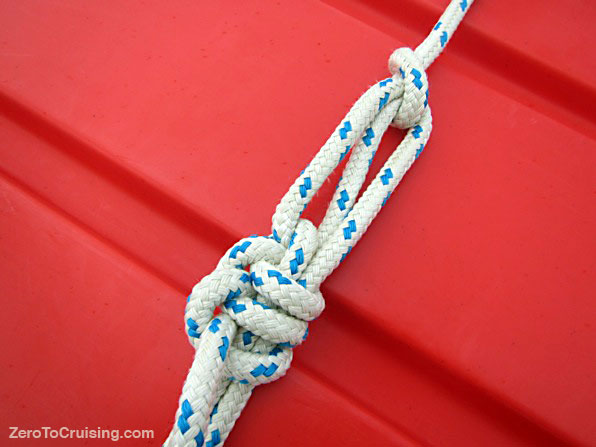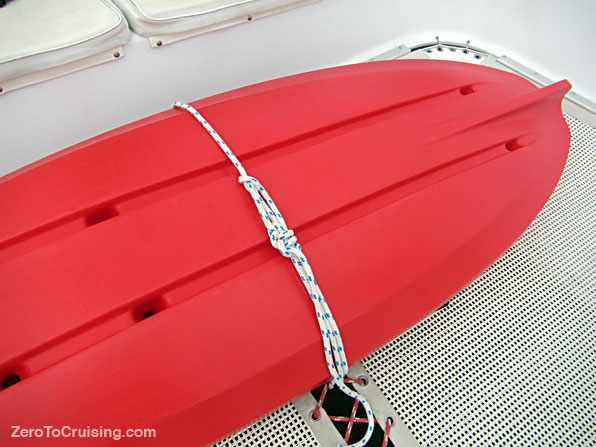Taking advantage
On a sailing yacht there are often huge weights and forces to contend with, and no matter how strong and fit you are, in many cases, without some method of mechanical advantage, you’d be unable to harness and control them. In situations like that, sailors typically put either a winch and/or a block and tackle to use.
On a few occasions in the past I have briefly mentioned a knot called the Trucker’s Hitch. The Trucker’s Hitch essentially forms a crude block and tackle arrangement and, although it imparts a fair bit more friction to the equation than a setup using modern blocks, it still helps to impart a mechanical advantage which can help you to effectively tighten down loads. When we unstepped our mast in Oswego, NY on our initial trip south, we used that hitch to help secure the spar on deck. Although we later had to resort to using blocks and our boat’s winches to cinch it down further, the hitch did a pretty good job.
Knots, in my way of thinking, are a bit like tools in a toolbox. There are some that we use almost daily while there are others that are still valuable but are called upon less frequently. While some people may use a knot like the Trucker’s Hitch often, since the time that I just mentioned, we really haven’t had too much demand for it. Since acquiring our kayak though, we have begun to use this knot fairly regularly to secure the boat onto the trampoline during short sailing trips. Yes, I know that the tramp is probably not the best place to store the kayak, and we’ll be working out a system to carry it on the side deck before we make any large passages, but with the help of this knot, so far it has been very secure on the tramp during the times that we have been underway.


One of the best online resources for knots is Animated Knot’s by Grog. Here is the direct link to the page which can teach you how to tie the Trucker’s Hitch.
And speaking of heading south (remember I mentioned that above?), this is the time of year when many people are making the journey from Canada down through the canal systems. If any of our readers are doing so now, or are about to begin that trek, they might find this post about the tools that we used and the following video to be of help. Have fun!




From the shroud forward, strapped to the shroud turn buckle aft and stanchion forward, has worked for us. No further back, or it is in the way getting around the cabin. We’ve beat into 20-knot ocean head winds without really getting it wet. Yup, with a truckers hitch!
Do be careful not to scratch windows; we leave the covers on on that side when it’s there.
And yet, I only keep it there because it is a bit longer and won’t fit properly across the tramp like yours. I’m not so certain that your location isn’t best most of the time. The only day we ever took real green water on the bow was in the wake of a hurricane and perhaps, just maybe, we shouldn’t have been there;) Even then, the side deck only took spray and the kayak was fine.
Thanks, Drew.
Talking about the kayak, how have you enjoyed it? Being the adventorous type, I would imagine a nice kayak and mountain bike would be essential for recreation for me. With a kayak, you can store it on deck as you have, but during a passage and especially during h-season when a storm is in the area, where do you store it? For a mountain bike, I would imagine it to be a little bit easier than a 14ft kayak. You could store it on deck locked to rail and sunbrella cover for rust protection and uv protection. A bike can easily be broken down with some pliers to undo the bolts. This is me just guesing, not sure if these are practical methods. Hopefully you can share some insight.
Patrick
It is Rebecca’s kayak and she has enjoyed it quite a bit. It is quite a bit shorter than 14 feet so storing it on deck is not a big issue for us. The bikes fold up in their own carry cases so we can store them inside in our spare berth. We only need to move them on deck when we have guests, which seldom happens. Many people do leave their bikes on deck though, leaning up against or attached to the lifelines/stanchions.
For those with iPhone or iPad (not sure about Android) there is a great knot app put out by Columbia called WhatKnot. Great step by step, catalogue and glossary. I use it both on and off the water. I’m sure there are other apps too, but this is the one I use often.
Thanks for the recommendation. I know that Animated Knots dot com advertises their own app too.